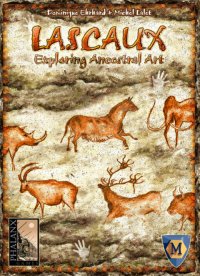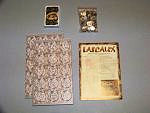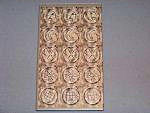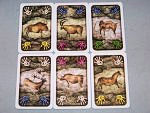
|
Lascaux A game by Dominique Ehrhard, Michel Lalet and Philippe des Pallières Published by Phalanx Games and distributed in the US by Mayfair Games, Inc. Players: 3-5 Time: 30 minutes Reviewed by Susan Rozmiarek |

|
Lascaux is a game loosely themed on the famous prehistoric paintings of animals found in caves in France.
Components:- 54 cards – these depict animals and colored handprints
- 50 stones – these appear to be actual bits of polished shell
- 30 cardboard tokens – a set of six tokens for each player
- Rules – These are nicely illustrated with lots of examples.
Game play:
In addition to an animal, each card also shows two of the six different colors. Players each have a set of 6 tokens, one side depicting a color and the other showing their player symbol. They also start the game with 12 stones (10 in a five-player game). At the start of each round, the deck is shuffled and cards are turned up and placed in a row until either all six colors are showing or seven cards have been turned up. The players now secretly choose one of their tokens and place it facedown in front of them so that the color side is hidden. They hope to be able to claim the cards of that color at the end of the round. In turn order, players may now bid for cards by placing a single stone in the center of the table. Play continues to go around until all players pass. When a player passes, he takes all of the stones currently in the center of the table and places his facedown token near the row of cards. As players pass, they add their token to form a stack with the first passing player’s token on the bottom and the last player’s on the top. Players must pass if they run out of stones. Once everyone has passed, the top token is turned over. That player gets to take all the cards showing the color on the token and add them to his collection. The same is repeated with each token in order with players taking all cards matching their token color IF there are cards with that color left. Each player’s collections of cards are displayed openly on the table in front of him.
Any cards remaining are left the table and cards are added for the next round using the same rules up to a maximum of seven again. The player who passed first the previous round starts the bidding. The game ends when all the cards in the deck have been claimed. The player with the majority in each animal type gets points equal to the number of cards he has of that animal. If more than one player is tied, each gets the points. In addition, players get one point for every six stones they have at the end of the game. The player with the most points wins.
Discussion:
Lascaux also uses the very clever mechanism that I’ve seen in two other games, No Thanks! and Mogul, that of paying a single stone or chip to stay in the round and collecting them all when you drop out. This provides a tense little sub-game of money management. You want to time your decision to pass so that you get the maximum number of stones when you do. This requires keeping an eye on how many stones each player has and guessing how badly they want to stay in the round. If you push things too far and the player before you passes unexpectedly, you might be left with few stones to bid with in the next round. This is very simple and clever bidding mechanism and it is used well here. In fact, if you enjoy No Thanks! but would like a little more depth, then you will probably be very pleased with Lascaux.
As with many games of outguessing your opponents, I feel that Lascaux works a little better with fewer players. With a full table of five, the players who passed early were likely not getting any cards. With three, it was easier to try and guess how the round might go and it felt less chaotic. Even then, you can never totally be sure what your opponents will choose and the surprises and uncertainty are part of what I enjoy about this type of game. I have not yet tried a four player game.
Lascaux is an excellent game that plays in about 30 minutes. It is very simple to learn and I’d heartily recommend it for both casual family players and serious gamers looking for a short, light game with a bit more depth than others of this type.
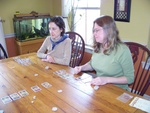
Lauren and Susan play Lascaux. |
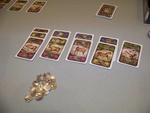
Lascaux "money" stones and cards in play |
| Other Web information: |
This page viewed
E-mail Ed Rozmiarek with questions or problems concerning this page.
Copyright © 2008, Ed & Susan Rozmiarek. No portion of this website may be reproduced or copied without the consent of Ed or Susan Rozmiarek.
